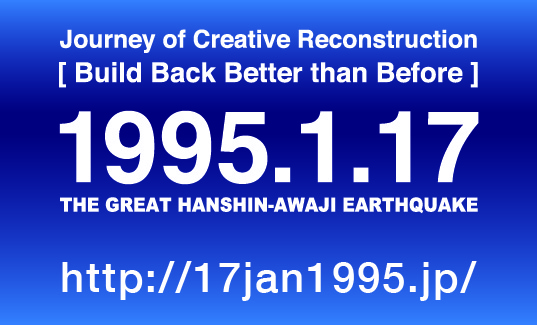The Great Hanshin-Awaji Earthquake
Journey of Creative Reconstruction
[Build Back Better than Before]
Site Guidance
In July 1995, 6 months after the Great Earthquake, Hyogo Prefecture formulated the Great Hanshin-Awaji Earthquake Reconstruction Plan. The plan aimed not merely to restore the previous status quo but to carry out a slogan of "Creative Reconstruction (Build Back Better than Before)" adopting a new perspective in anticipation of coming aging society and mature society in the 21st century, and various projects based on the plan were developed.
As a part of symbolic recovery project, Hyogo established Disaster Reduction and Human Renovation Institution (DRI) and invited UN agencies, such as UNISDR, OCHA and WHO to set up their Japanese offices from a perspective of international cooperation promotion for disaster reduction. Hyogo has held International Disaster Reduction Forum every year together with those related agencies and developed human resources specialized disaster risk reduction in Japan and abroad.
For the UNISDR World Campaign on "Making Cities Resilient" (2010- 2015), Hyogo Prefecture is accredited as "Role Model" and Mr. Toshizo Ido, Governor of Hyogo, is designated as "Champion".
Following the fact that Hyogo is granted such honorable position, Hyogo implements to build disaster-resilient, safe and secure society, and makes a contribution to play the major role in world disaster risk reduction.
Purpose of Exhibition
The purpose of the exhibit is to introduce efforts in Hyogo, such as damage status caused by the earthquake, and efforts on restoration and reconstruction during these 20 years for "Creative reconstruction (Build Back Better than Before) to the participants in the WCDRR.
Summary of exhibits
1) Looking back: 17 January 1995 (reproduction film at the moment of the earthquake)
The earthquake struck at 5:46am on January 17, 1995. The great shake having a seismic intensity of 7 (JMA scale) that was the greatest quake ever recorded in Japan attacked Hanshin-Awaji (between Kobe and Osaka and Awaji) area. As a display element of DRI, the situation of cities at the moment of the earthquake was reproduced precisely in a 7 minutes film using special effects technology. The special digest version of this film is played here.
2) Learning from photograph
60 shots selected from documentary photographs which captured damages caused by the earthquake and the process of restoration and reconstruction are displayed.
3) Learning from data
Around 15 data graphics are displayed to make visitors understand directly regarding scale and damages of the earthquake.
The date and the time of occurrence, name, magnitude, seismic center, area of seismic intensity level 7, human damages, building damages, fire occurrence, cause of death, rescue, total amount of damage, (restoration of essential line), the number of evacuees, the number of emergency temporary housings, the number of volunteers, etc.
4) Learning from museum artifacts
Material room in Disaster Reduction and Human Renovation Institution collected approximately 190,000 pieces of disaster-related primary materials such as objects, papers and photographs. Around 25 symbolic disaster remains are selected from those materials and introduced.
- materials that described the time of occurrence, and impact and damage
- materials that described relief goods and people's lives at shelters and temporary housing
- materials that described the process from restoration phase to reconstruction phase
5) Looking back over the timeline
The timeline showing the histories during 20 years from 1995 (the time of occurrence) to January 2015 are displayed. It can be passed around in sequence to look at.
6) 20 years efforts after the Great Hanshin-Awaji Earthquake in Hyogo.
"Hyogo Framework for Action (HFA)" was adopted at the 2nd UN World Conference on Disaster Reduction held in Kobe, Hyogo in 2005. Efforts in Hyogo in line with HFA for the past 20 years are shared. The contents are quoted from "Priorities for Action 1~5" and "Efforts on Creative Reconstruction" in the booklet titled "20 Years from the Great Hanshin-Awaji Earthquake; Recommendation from Hyogo ~ Initiatives towards the Post 2015 Framework for Disaster Risk Reduction ~" (March 2015 publication) which summarized the 20years efforts in Hyogo after the Earthquake and recommendation toward the Post 2015 Framework for Disaster Risk Reduction.

presented by
The Great Hanshin-Awaji Earthquake Memorial
Disaster Reduction and Human Renovation Institution
http://www.dri.ne.jp